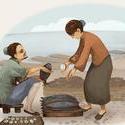Live Loach
One fish that you’ll find in a tank in most supermarkets and markets (or sometimes in buckets by the roadside) are 泥鳅 (ní qiu) - Loach. These are not a single species or even one family; there are an astonishing 1,249 known species in nine families. The most commonly consumed here are Misgurnus anguillicaudatus, usually referred to in English as the “pond loach” or “weatherfish”. These native to East Asia and are extensively farmed commercially, but in the countryside villages are found in the rice paddies. Ovre the last decade, they have been found in the southern USA.
About 4 - 5 inches / 10 - 13 cm long, pond loach are bottom feeding scavengers, mainly eating algae, but also known to eat small worms and aquatic creatures such as snails. They are covered in a mucus which enables them to survive long periods out of water.
They are popular in Korea and Japan where they are used in soups The Korean soup is chueo-tang (추어탕), whereas the Japanese version is dojō nabe (ジョウ鍋). Here in China, though, I’ve only ever had them stir fried (skin and bone on) with the usual garlic, ginger and chilli triad and vegetables, often water spinach aka moning glory. I’ve cooked them this way several times, but also just by dredging them in potato starch (the uncivilised use cørn starch) and deep frying until crisp. Drain sprinkle with salt and chilli powder and Robert is your father’s brother. Great beer food.
Please note, they go into the hot oil still alive but die immediately.
My Deep Fried Loach
If frying them is too much trouble, worry not. The supermarket sells them pre-cooked, too.
Supermarket Fried Loach


.thumb.jpg.8c4c94cb6262bc46ea2fdbf50c747478.jpg)
.thumb.jpg.f3894ff1db9acbec9e5697c069f9d33d.jpg)

